
The nene, also known as the nēnē or the Hawaiian goose, is a species of bird endemic to the Hawaiian Islands. The nene is exclusively found in the wild on the islands of Oahu, Maui, Kauaʻi, Molokai, and Hawaiʻi. In 1957, it was designated as the official state bird of the state of Hawaiʻi.
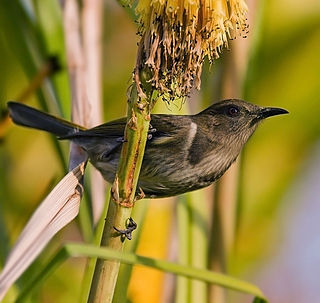
The honeyeaters are a large and diverse family, Meliphagidae, of small to medium-sized birds. The family includes the Australian chats, myzomelas, friarbirds, wattlebirds, miners and melidectes. They are most common in Australia and New Guinea, and found also in New Zealand, the Pacific islands as far east as Samoa and Tonga, and the islands to the north and west of New Guinea known as Wallacea. Bali, on the other side of the Wallace Line, has a single species.
Located about 2300 miles (3680 km) from the nearest continental shore, the Hawaiian Islands are the most isolated group of islands on the planet. The plant and animal life of the Hawaiian archipelago is the result of early, very infrequent colonizations of arriving species and the slow evolution of those species—in isolation from the rest of the world's flora and fauna—over a period of at least 5 million years. As a consequence, Hawai'i is home to a large number of endemic species. The radiation of species described by Charles Darwin in the Galapagos Islands which was critical to the formulation of his theory of evolution is far exceeded in the more isolated Hawaiian Islands.

The Kauaʻi ʻōʻō or ʻōʻōʻāʻā was the last member of the ʻōʻō (Moho) genus within the Mohoidae family of birds from the islands of Hawaiʻi. The entire family is now extinct. It was previously regarded as a member of the Australo-Pacific honeyeaters.

The friarbirds, also called leatherheads, are a groups of 18 relatively large honeyeaters in the genus Philemon. Additionally, the single member of the genus Melitograis is called the white-streaked friarbird. Friarbirds are found in Australia, Papua New Guinea, eastern Indonesia, and New Caledonia. They eat nectar, insects and other invertebrates, flowers, fruit, and seeds.

The Hawaiian rail, Hawaiian spotted rail, or Hawaiian crake is an extinct species of diminutive rail that lived on Big Island of Hawaiʻi.
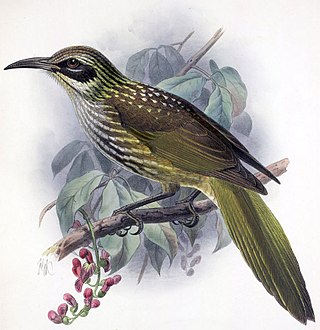
The kioea was a endemic Hawaiian bird that became extinct around the mid-19th century.

The Alakaʻi Wilderness Preserve, popularly known as Alakaʻi Swamp, is a montane wet forest on the Hawaiian island of Kauaʻi. Although the preserve is home to alpine bogs, it is not a true swamp. It is located on a plateau near Mount Waiʻaleʻale, one of the wettest spots on Earth. Due to its unique combination of high elevation and climate, the Alakaʻi Swamp harbors a large number of endangered endemic species that are only found in this area and whose population has been dramatically declining over the last decades. It is designated as a IUCN protected area.

The Hawaiʻi ʻōʻō is a member of the extinct genus of the ʻōʻōs (Moho) within the extinct family Mohoidae. It was previously regarded as member of the Australo-Pacific honeyeaters (Meliphagidae).

The Bishop's ‘ō‘ō or Molokai ‘ō‘ō was the penultimate member of the extinct genus of the ‘ō‘ōs (Moho) within the extinct family Mohoidae. It was previously regarded as member of the Australo-Pacific honeyeaters (Meliphagidae). Lionel Walter Rothschild named it after Charles Reed Bishop, the founder of the Bishop Museum.

Mamo or woowoo is a common name for two species of extinct birds. Together with the extant ʻIʻiwi they make up the genus Drepanis. These nectarivorous finches were endemic to Hawaii but are now extinct.

The O‘ahu ‘ō‘ō was a member of the extinct genus of the ‘ō‘ōs (Moho) within the extinct family Mohoidae. It was previously regarded as member of the Australo-Pacific honeyeaters (Meliphagidae).
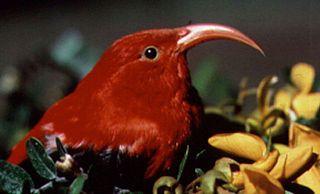
Hawaiian honeycreepers are a group of small birds endemic to Hawaiʻi. They are members of the finch family Fringillidae, closely related to the rosefinches (Carpodacus), but many species have evolved features unlike those present in any other finch. Their great morphological diversity is the result of adaptive radiation in an insular environment. Many have been driven to extinction since the first humans arrived in Hawaii, with extinctions increasing over the last two centuries following European discovery of the islands, with habitat destruction and especially invasive species being the main causes.
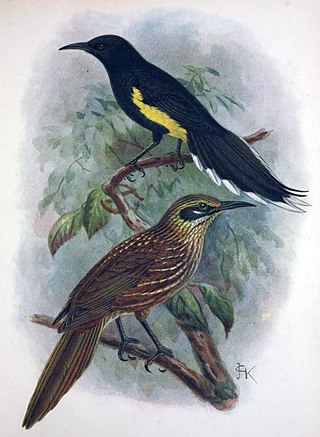
Mohoidae, also known as the Hawaiian honeyeaters, was a family of Hawaiian species of now recently extinct, nectarivorous songbirds in the genera Moho (ʻōʻō) and Chaetoptila (kioea). These now extinct birds form their own family, representing the only complete extinction of an entire avian family in modern times, when the disputed family Turnagridae is regarded as invalid. The last surviving species in the family, the Kauai O'o, became extinct after 1987.
Harold Douglas Pratt Jr., often credited in the short form H. Douglas Pratt or as Doug Pratt, is an American ornithologist, bio acoustican, wildlife photographer, bird illustrator, and musician. His main research field are the endemic avifaunas of Hawaii and other islands in the Pacific where he was one of the pioneers of the voice recordings of birds. Pratt is a Fellow of the American Ornithologists' Union.

Hawaiian feather helmets, known as mahiole in the Hawaiian language, were worn with feather cloaks. These were symbols of the highest rank reserved for the men of the aliʻi, the chiefly class of Hawaii. There are examples of this traditional headgear in museums around the world. At least sixteen of these helmets were collected during the voyages of Captain Cook. These helmets are made from a woven frame structure decorated with bird feathers and are examples of fine featherwork techniques. One of these helmets was included in a painting of Cook's death by Johann Zoffany.
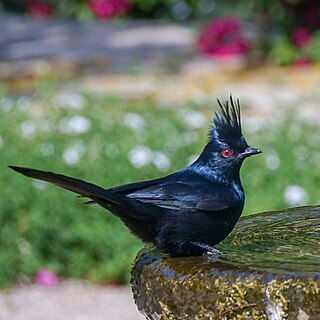
Bombycilloidea is a superfamily of passerine birds that contains ten living species. They are found in North, Central America, most of the Palearctic, the Arabian Peninsula, the islands of Hispaniola and Sulawesi, and formerly the Hawaiian Islands.



















